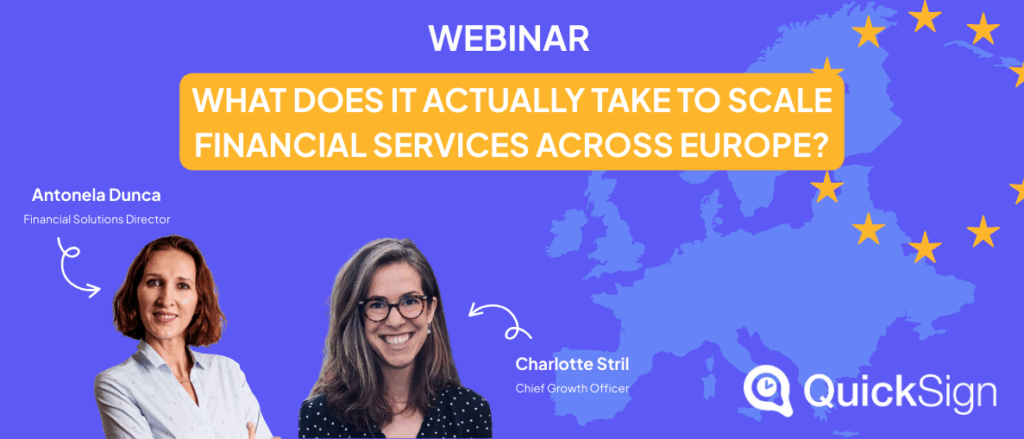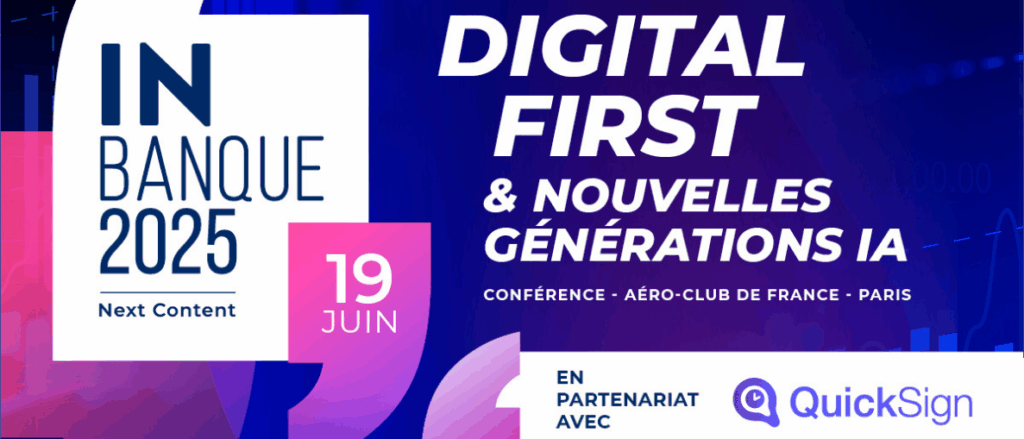What Does it Actually Take to Scale Financial Services Across Europe

Deploying a seamless, compliant, and unified customer journey across several European countries, how do you actually make it happen?That’s the question we explored during a QuickSign webinar dedicated to the international expansion of financial services. An expert-led session designed to share real‑life insights and hands‑on feedback from the field. Webinar : Why Digital Onboarding Is a Strategic Lever in Europe This webinar started from one simple belief: digital onboarding is a key growth driver for financial institutions aiming to scale across Europe.But between ambition and execution, the reality can get messy. To explore what successful scaling really looks like, Charlyne Doche, Head of Marketing at QuickSign, invited two speakers with complementary expertise: Together, they revisited a concrete deployment across four countries—France, Germany, the UK and Italy. A memorable collaboration that clearly showed how complex scaling can be, and how essential strong project governance is. This webinar follows a previous Breakfast With podcast episode, where the same duo discussed the future of onboarding in the mobility sector. Two Field Experts, One Shared International Experience Harmonise? Yes. Standardise Everything? Not So Fast. One of the key insights from the webinar: the temptation to build a one-size-fits-all journey for all countries is strong—but rarely works in practice. It sounds ideal: one API, one interface, one back office.But the European landscape tells another story: “You can’t just replicate a journey from one country to another. You have to adapt to the culture, the standards, and sometimes even the language.” – Antonela Dunca In short: copy-pasting is not scaling.The real challenge is to find the right balance between strategic harmonisation and local adaptation. And that requires flexible technology, configurable business rules, and clear governance. The Foundations of a Truly Scalable Architecture Flexibility must not mean chaos. As Charlotte Stril pointed out, scalable onboarding needs an architecture that’s both modular and industrialised—capable of handling multi-country deployments without starting from scratch. Key pillars include: But architecture isn’t everything. Methodology makes the difference: early scoping, local team alignment, fast iterations, and continuous feedback. “Lowering costs, centralising tools, unifying data—it’s possible. But only with real orchestration and the right method.” — Charlotte Stril Scaling Is Not Duplicating. It’s Designing for Complexity. This webinar served as a reminder: scaling doesn’t mean duplicating. It means building systems and teams that can absorb complexity—without being slowed down by it. To succeed with pan-European digital onboarding, you need to: QuickSign: Your Partner for Scalable Onboarding This is exactly where QuickSign comes in. We help financial institutions deploy scalable digital onboarding journeys—without compromising on compliance or agility.Our solution is purpose-built for the financial sector. It adapts to local constraints while offering a common, industrial-grade foundation. Being the right partner means turning complexity into perceived simplicity.And that’s what we do—every day—with our clients. Watch the full replay on QuickSign’s YouTube channel For more information, contact us or visit our platforme page Written by Isalys L.
InBanque 2025: Choosing the Right Digital Onboarding Provider for Consumer Credit Can Make All the Difference

QuickSign was a partner of InBanque 2025, the flagship event dedicated to innovation in financial services. This 11th edition shed light on evolving customer expectations, the impact of technologies (especially GenAI), and the ongoing transformation of the banking landscape. It was the perfect opportunity for QuickSign to share its vision of digital onboarding: a strategic lever to deliver instant, compliant, and conversion-driven customer journeys. InBanque 2025: A Key Event for Banking Innovation On Thursday, June 19, 2025, QuickSign was a partner of the 11th edition of InBanque, organized by Next Content at the Aéro-Club de France. This event has become a must-attend for all players seeking innovation in the financial sector. From the opening session, the tone was set: the 2025 edition of InBanque focused on the hybridization of digital and human experiences in banking services—more relevant than ever. On the agenda: Next Content, a consultancy firm specialized in digital innovation, organizes the event each year. With InBanque (and Innovation Assurance), they break down the major trends shaping banking and insurance services. QuickSign, an event partner for the second consecutive year, took things a step further this time—by stepping on stage. Consumer Credit: QuickSign Shares Its Vision at InBanque During the panel discussion “Digital Services, Customer Journeys & Strategies – Focus on Financing Solutions,” Thibaut Ravise, CEO of QuickSign, spoke alongside Anaïs Desmoulins (Sofinco) and Julien Montel (Retail). The goal: to share our experience with digital onboarding in consumer credit. InBanque Consumer Credit: Key Takeaways Today, consumer credit is no longer just about interest rates. It’s about: At QuickSign, our role is to orchestrate that complexity. Our solution enables: Transformation Requires the Right Partners Consumer credit is undergoing a major shift: At QuickSign, we believe the credit of tomorrow will be: And to make that happen, you need more than just a tool. You need the right partner. And if you too want to talk about financing journeys, instant credit, KYC, or e-signature…Get in touch—we’d love to chat! Written by Isalys L.
BankTech Day 2025 : Are Digital Banks Winning the Race ?

On April 30, 2025, the second edition of Bank Tech Day took place in Paris. The event once again confirmed its role as a key gathering for innovation in banking and financial services. Organized by Finance Innovation, the conference brought together leading figures from finance and tech. The objective: to discuss the major shifts shaping the future of banking. This year, the conference was hosted at the prestigious Opéra Garnier, a setting as ambitious as the topics covered throughout the day. More than 1,300 participants attended the event, including executives, product leaders, compliance experts, and fintech founders. With three simultaneous stages, a comprehensive exhibition space, and a dense program of talks and discussions, the event offered both strategic insights and operational takeaways. For the first time, QuickSign took part as an official partner and sponsor. Our teams were on site throughout the day to engage with industry leaders and share our vision for secure, compliant, and scalable onboarding digital in financial services. QuickSign hosts expert panel: “Are digital banks winning the race?” As part of the program, QuickSign hosted a panel discussion exploring a central question in the financial services ecosystem: “Are digital banks winning the race?” The panel featured industry executives: Three key takeaways emerged from the session, reflecting the core dynamics of digital banking today. 1. Smaller teams, sharper expertise Digital banks operate with lean, highly specialized teams. This agile structure allows for faster innovation cycles, smoother adaptation to user needs, and more effective optimization of customer journeys — particularly during the onboarding phase, which is increasingly viewed as a key competitive differentiator. Balancing conversion, fraud, and compliance One of the most complex challenges remains finding the right balance between delivering a seamless customer experience and ensuring full compliance with regulatory frameworks. Digital-native institutions address this through data-driven strategies, robust KYC systems, and automation tools that support both risk management and operational efficiency. Pricing as an entry point, value as a growth driver for digital banks While competitive pricing remains a key acquisition lever for digital banks, long-term growth depends on more than just cost advantage. Success is built on the ability to earn user trust, deliver high-value services, and scale operations sustainably — all within a secure and compliant framework. While digital banks have shown strong momentum, they still face important challenges. First, they must achieve critical mass. Without sufficient volume, their business models risk stalling, especially in markets with thin margins and high compliance costs.Second, geographic expansion is both an opportunity and a hurdle. Entering new markets means adapting to different regulatory frameworks, user behaviors, and competitive landscapes.Third, and perhaps most importantly, is the need to build strong, credible brands. In financial services, brand trust is a cornerstone. Customers need to feel confident that their bank — whether digital or traditional — is secure, transparent, and here to stay. This is especially true in a world where reputational risks can spread rapidly. A strong brand is not just a marketing asset; it’s a strategic shield. QuickSign’s perspective At QuickSign, we believe that digital banks are not merely keeping pace with traditional players — they are actively redefining what banking should look like in the digital age. Our mission is to support this transformation by providing a secure, compliant, and scalable digital onboarding solution, built for international growth and aligned with the expectations of today’s most demanding financial institutions. For a behind-the-scenes look at the event, watch our exclusive Bank Tech Day 2025 vlog. Contact us to discuss! Written by Isalys L.